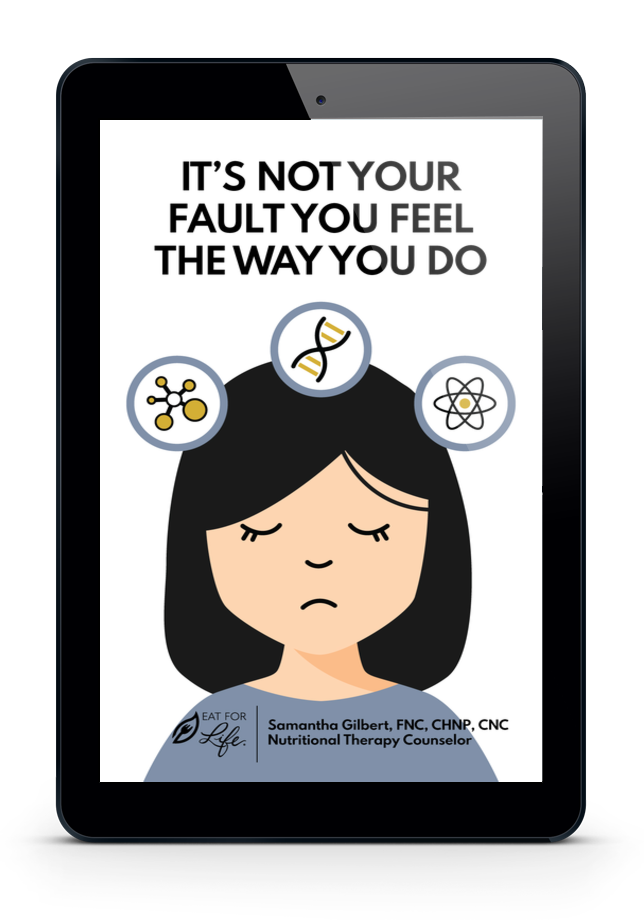Breast cancer, methylation, and copper toxicity share common links: Estrogen dysregulation, endocrine disrupters, and a genetic inability to produce protective methyl groups to support the production of enzymes, hormones, and neurotransmitters (otherwise known as undermethylation).
If you’ve had breast cancer or are currently struggling with this diagnosis (or have a loved one with it), then this post was created for you.
Breast cancer runs in my family.
My paternal grandmother was diagnosed with breast cancer at a time in our history when little was known about it, and the treatment consisted of “whacking off both breasts” as my grandmother explained it to me when I was a little girl.
Years later, my maternal grandmother would also need a double mastectomy.
Much is known about genetic mutations, estrogen, our environment, and lifestyle factors in the development of breast cancer, but little is known or understood about the role copper toxicity and a genetic condition known as undermethylation play in breast cancer.
Two underlying causes one should always look at with a breast cancer diagnosis are copper levels and methylation status.
Let’s unpack them.
Breast Cancer: Copper Toxicity and Estrogen Dominance/Sensitivity
Simply put, copper toxicity, often hereditary, is an inability to effectively eliminate excess copper. It is not the same as Wilson’s Disease, a rare genetic disorder where copper accumulates in vital organs and glands.
This condition is becoming more and more common in women because estrogen increases copper retention in the body, and certain subtypes of breast cancer are estrogen sensitive. We live in an estrogen-dominant world, and it is well documented that estrogen dominance/sensitivity plays a direct role in the development of many cancers including those of the breast, ovaries, and cervix.
Copper toxicity is triggered by, and increases with, the use of birth control, hormone therapy (bioidentical and synthetic), tap and well water, copper pipes, xenoestrogens (toxins that mimic estrogen in the body), pesticides, plastics, fuels, dry cleaning chemicals, industrial waste, growth hormones from conventional feedlot animals, and many household and personal care products. The progression of these environmental triggers explains why copper toxicity is quite common today.
The popularity of plant-based diets (which are naturally high in copper) is also a contributing factor.
Anything that can elevate estrogen is a problem, including supplements and dietary sources. The most common culprits include oral contraceptives, the copper IUD, and hormone replacement therapy.
Common symptoms for this subtype of breast cancer patients include a history of severe PMS issues (especially irregular and painful menstrual cycles), fibromyalgia, chronic fatigue issues, ovarian cysts, endometriosis, PCOS, and chronic migraine headaches.
These same females may also speak of severe or lifelong depression, anxiety, panic attacks, mood dysregulation, postpartum depression and in some cases, postpartum psychosis.
I even wrote a Low Copper Cookbook with lots of delicious recipes, the complete list of low copper foods, and more in-depth research here.
Breast Cancer: Undermethylation
Because methyl is protective by nature, a genetically acquired lack of methyl (otherwise known as undermethylation) can make an individual prone to cancer-causing substances simply because we make too few methyl molecules to add to enzymes, hormones, and neurotransmitters.
Undermethylators have excessive levels of folic acid, making all forms of folic acid (from food and supplements) poor dietary choices.
However, folic acid has a duality to it. In one area of the cell, folic acid donates methyl, but in the nucleus of the cell (where we are trying to affect change), folic acid actually removes methyl. Because the nucleus is the command center of the cell, when folic acid removes methyl, it can have detrimental effects such as the alteration of many cellular mechanisms including detoxification and cancer activity. This is because all forms of folate strip methyl at the level of DNA.
Researchers involved in the treatment of cancer now realize that folic acid is “associated with increased cancer incidence and cancer mortality after an additional median of 38 months of post-trial follow-up” (Ebbing M, Bønaa K. H, Nygård O, et al. 2009).
Additionally, Methotrexate, a drug used to treat cancer, acts by inhibiting the metabolism of folic acid. It’s a great cancer agent, but unfortunately, many patients’ condition worsened, and they lost their battle with cancer because folic acid was prescribed after the drug was taken. This is another indicator as to why undermethylated individuals have a higher propensity to develop cancer and the role that folate plays in its formation.
When working with a cancer patient, I always test methylation status as well as copper levels, among other diagnostic labs, to ensure the patient is not consuming anything contraindicated for their biochemical status and cancer diagnosis.
I also wrote a Low Folate Cookbook with the complete list of high, moderate, and low folate foods, as well as delicious recipes here.
Despite popular opinion, plant-based diets are not good choices for the breast cancer patient who has elevated copper levels and/or undermethylation.
I test methylation via a whole histamine blood test or methylation SAM/SAH profile.
Serum copper, zinc, and free copper (copper not bound to proteins) are essential to evaluate copper status. Hair Tissue Mineral Analysis is great for many things, but it’s a half analysis and doesn’t provide the full picture regarding copper toxicity.
I want to save women with breast cancer. If you are one or know one, I’m here to help answer the questions and provide solutions that are often overlooked.







12 Responses
I’m a breast cancer survivor for 1 1/2 years
That’s wonderful Leann!
Hi Sami, Does elevated copper and under methylation also apply for ovarian cancer?
Hi Shelly – Yes, unfortunately, it does.
If molybdenum is good for copper overload is it also safe then for undermethylators?
There’s a supplement called ammonium molybdate tetrahydrate and it comes in the form of a liquid. The dose is 3 drops and it effectively chelates copper from your blood and organs. Wilson’s disease patients take it, of course in larger doses but 3 drops per day is a safe dose. I read that it can also reverse some cancers. I’m not sure if it’s good for undermethylators though.
Please note molybdenum is not a nutrient you want to take without proper guidance.
Hi …l have been tested and l have
Undermethylation
High copper
Parole
High histamine
And recently had a lumpectomy for DCIS
I gave up be because l couldn’t get my head around how many food changes I had to make because of so many issues l had …is it possible to simplify this ?
Hi! I have compound heterozygous MTHFR mutations and I’m curious, does that count as being an undermethylator?
Hi Zaina,
No, the MTHFR test does not reveal methylation status.
Thank you for sharing this information. I am struggling to get the copper down and the zinc up even with GP support, long term issue. Where can I find information on what to do to lower copper ?
Hi Juls,
It’s really important to work with someone that can help you do this safely. Click here for information about working with me.